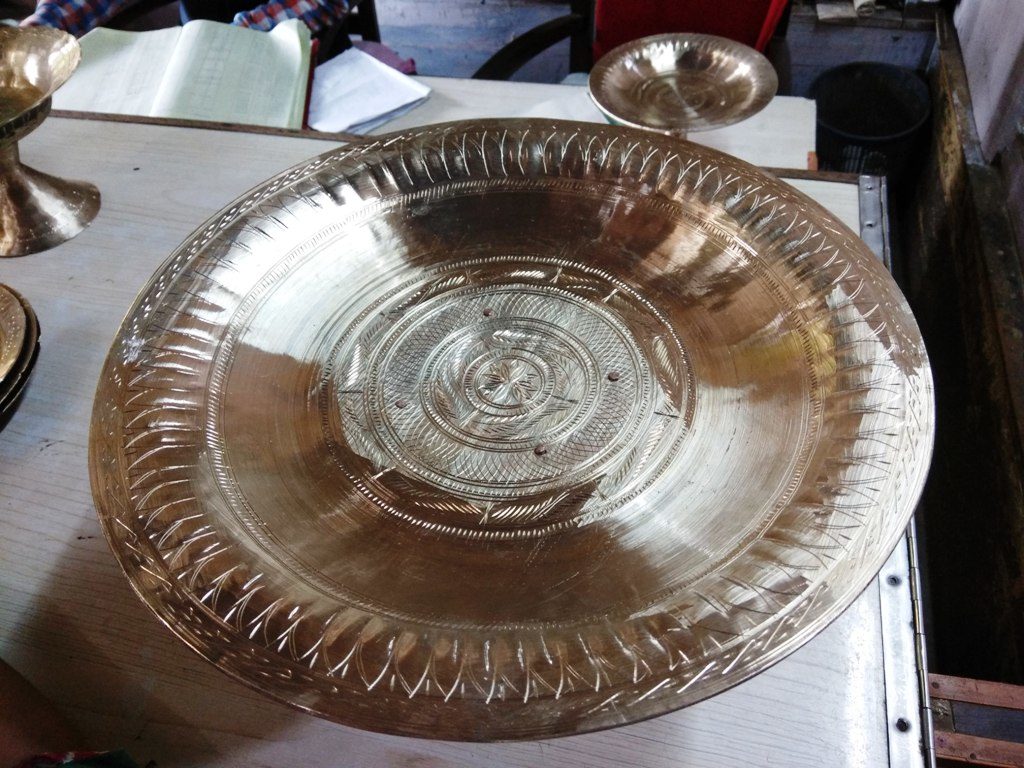The bell-metal industry of Assam is the second largest handicraft sector after bamboo craft. Bell-metal is an alloy of copper and tin and the craftsmen of this industry are referred to as ‘Kahar’ or ‘Orja’. The objects made are mostly used in domestic and religious purposes.
The tradition is believed to have started ages back and the craftsmen still prepare the objects manually adhering to the age old technique by implementing the old tools required for burning and shaping the metal. Historically, this craft form dates back to the 7th century AD. Various written records reveal that the bell metal industry of Assam existed from the time of Kumarbhaskarvarman, the king of the Varman Dynasty, when, the Kumar of eastern India gifted drinking vessels to Harshavardhana of Kannauj. The existence of the skilled bell-metal masters can also be traced through the scriptures, where its written that a pair of ‘Bhortal’ or cymbal, a musical instrument was gifted to Hieuen Tsang, an eminent Chinese scholar during his visit to India and Kamrup. However, scholars believe that it was only during the period of Ahoms that the industry got highlighted, as special interest was taken by various Ahom kings among whom Swargadeo Siva Singha was the most notable.
During the Ahom regime, the bell-metal industry in Assam has achieved the golden period. Everyone including the king, nobles and the subjects have been accustomed with the use of bell-metal utensils and as such bell-metal production of Sarthebari flourished. The Ahom king gave incentives to the artisans engaged in Sarthebari bell-metal industry. Encouraged by royal patronage, the artisans have enabled themselves to mould lovely looking Sarai, (a platter or tray) Gudgudi or hookah, Temi-bata (small lime container), Pikdani, (spittoon), Bhog-jara (water vessel with a spout) etc. The artisans have made bell-metal cannons for the battlefield use. The Ahom King and Nobles were complacent in using Maihang kahi (metallic plate) and Maihang bati (metallic cup) produced under special care by artisans of Sarthebari bell-metal industry. King Siva Singha is known to have showered laurels upon bell-metal artisan Jieu Dhan Kahar at the beginning of the 7th Century. Jieu Dhan Kahar was highly interested in pure art. As a token of recognition of his talent in art he was endowed with the title ‘Chaudhary’ along with a grant of 100 bighas (measure of land) of nispikheraj land. Jieu Dhan Kahar made a wooden tiger and its inside placed a pair of ‘Bhortals’ (large cymbals) made of bell-metal, which produces roaring sounds while moving. This tiger was presented to his Majesty Siva Singha, Ahom King. The descendants of Jieu Dhan Kahar are using the Chaudhary title till date. (Baishya, P. (1989) Small & Cottage Industries. A Study in Assam Manas Publication, New Delhi, p-169)
In the Assamese society the bell-metal utensils occupy an important place in the life and economy of the people. Sarthebari in the Barpeta district is a place well known for its bell-metal and brass-metal industry. One who takes a stroll around the village of Sarthebari can hear the sound of hammering the metal at the furnace from every passing household.
The common objects made by the artisans in Sarthebari are kalah (water pot), sarai (a platter or tray mounted on a base), kahi (dish), bati (bowl), lota (water pot with a long neck) and tal (cymbals). It is also believed that the utensils manufactured using bell-metal have certain medicinal properties and consuming food in these utensils keep intestinal problems at bay. Also, drinking water in bell-metal glasses aids in cleaning your body due to certain mineral present in these glasses. These were considered to be the prime reasons for serving food in such utensils to the Royal family of Ahom kings of the Great Ahom dynasty of Assam.
The technology involved in making the objects is traditional and simple. The main tools are anvils of different sizes locally known as balmuri, chatuli and akue , hammers, pincers, flies, chisels and some minor equipment. Locally they are called Dulari, Gasha, Saria, Piri, Khanta (an iron instrument use for polishing the bell metal products), and Pocker etc. The other raw materials are polishing materials, clay, jute fiber, rice bran, mustard oil, Charcoal, Borax, Zinc, shalpatra etc. No machinery is used in the process and from creating the mould to the final polishing, everything is done manually.
The objects made of bell-metal are heavier and bulkier in weight because of the extensive use of metal. This craftsmen inherit the knowledge from their elders and thus the industry runs on hereditary system. Modem tools and technology has not yet touched the lives of the artisans and they still adhere to primitive tools and equipments in bell-metal production. One major problem faced by the industry is the supply of raw materials which is usually purchased from the middleman.
Also, abundantly available cheaper objects made with aluminum , plastic etc, slowly engulfing the entire cottage industry market is another threat faced by the craftsmen of Sarthebari.
References:
- Baishya, Prabin (1989). Small and cottage industries: a study in Assam. Manas Publications. p. 336.
- Goswami, M. (2009): The Bell Metal Industry in Assam; a Study on Sarthebari (1880-1947), M. Phil. Dissertation, submitted to Department of History, Assam University, Silchar, p. 47
- Kalita, B. (2008),: A Geographical Analysis of Bell Metal Industry in Sarthebari, Amar Asom, 23rd March, 2008, p-6
